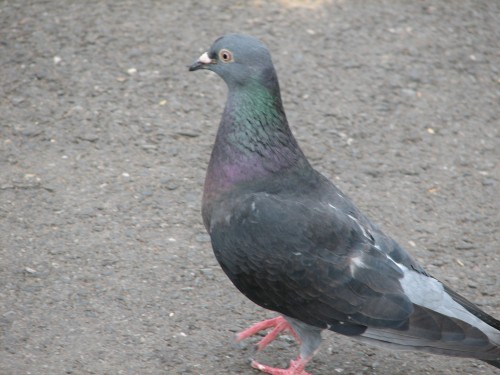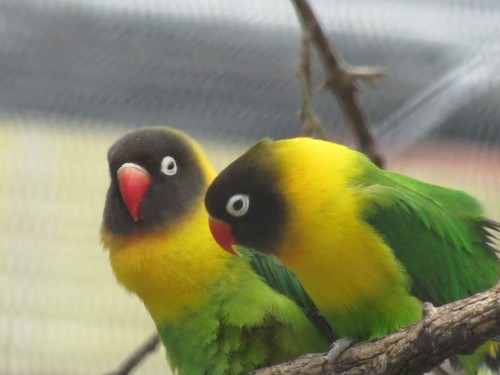Rock Dove
I don’t normally pay much attention to photographing introduced species, but this Rock Dove strutting around in the grounds of Adelaide Zoo caught my eye. It was almost right under my feet, the camera was ready to shoot and the bird was posing appropriately, so I took the photo.
Rock Doves, also called Feral Pigeons, are common throughout Australian cities and towns. They are especially common here in South Australia around cereal grain handling facilities, even in remote rural areas. The free grain available in such places provides a sustainable source of food. When I travelled overseas I discovered that they are very common in most places.
This individual, one of many, was feeding on food dropped by people visiting the zoo. The outdoor restaurant area was only a few metres behind me when I took the shot.
Yellow-collared Lovebird, Adelaide Zoo
I must admit that I am not a fan of Lovebirds. I have heard that they can be very aggressive as a cage bird. I am also wary that some will escape from captivity and establish feral populations here in Australia. This has happened with other species over the years and it would mean that they would compete with native species for food and nesting sites.
Despite these feelings, I must admit that the birds shown in my photos today are attractive, so I can understand why some people would want to keep them as pets. These photos were taken through the wire of an aviary in the Adelaide Zoo here in South Australia.
Yellow-collared Lovebirds are native to Tanzania in southern Africa.
Ostriches at Monarto Zoo, South Australia
One of the interesting birds you can see at the Monarto Zoo near my home town of Murray Bridge is the Ostrich. The zoo boasts a large flock of this species and they breed readily in captivity.
Ostriches are native to Africa but there have been some feral populations in different parts of South Australia over the last century and a half. Originally they were imported and farmed for their feathers. These were used for decorations, usually in ladies’ hats. When this fashion quickly faded the industry declined and some birds were released and formed feral breeding populations, especially along the Coorong south east of Adelaide, and north east of Port Augusta. From time to time there are reports of small flocks still living in that area.
More recently there has been short lived resurgence in the farming of this species, this time as a meat bird.
Feral Pigeons pipe dream home
We have quite a few Feral Pigeons (Rock Doves) in various places around our home town of Murray Bridge, South Australia. They are present in large numbers around the CBD and the various large factories and other types of buildings around town.
On our way home from visiting the shopping areas we often drive past a used steel and metal outlet. Along the boundary fence they have some large racks on which are stored numerous steel pipes, as shown in the photos. The local feral pigeons have decided that these pipes make excellent apartment buildings. They have been nesting and roosting in the pipes for quite a few years. Obviously there is no great demand for these pipes in the used pipe business.
I’ve often tried to remember to take my camera with to get a few photos of them. I remembered earlier this week.
What I want to know is how they survived the heat of our recent extreme summer. With air temperatures often reaching 48C+ and the sun temperature probably 55-60C, how did they survive. And were the eggs in the nests cooked nicely after several such days of high temperatures?







